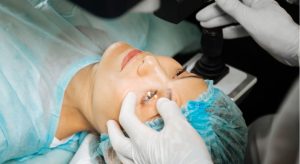Can PRK Surgery Fix Astigmatism?

If you have astigmatism and you’re frustrated with blurry, distorted or inconsistent vision, you might be wondering whether PRK surgery can fix it. Many people assume that astigmatism is “too complicated” for laser correction or that LASIK is the only option. The truth is that PRK is one of the most successful and reliable treatments for astigmatism even for people who aren’t suitable for LASIK due to thin corneas, dry eyes or lifestyle factors.
As someone who has spoken to countless people exploring vision correction, I know how confusing it can feel when you’re trying to understand whether your specific eye prescription can actually be treated. Astigmatism often sounds complex, and you might worry that it reduces your chances of achieving clear vision. In this guide, I’ll walk you through exactly how PRK fixes astigmatism, what results you can expect, who makes an ideal candidate and how PRK compares with LASIK for astigmatism correction.
What Is Astigmatism and Why Does It Affect Vision?

Astigmatism happens when your cornea or lens is shaped more like a rugby ball instead of a football. This irregular curve causes light to scatter instead of focusing sharply on the retina.
Symptoms often include:
- Blurry vision
- Ghosting or double vision
- Distortion
- Difficulty seeing fine detail
- Eye strain
- Headaches
- Poor night vision
Astigmatism is extremely common and often occurs alongside short-sightedness (myopia) or long-sightedness (hyperopia).
How PRK Corrects Astigmatism
PRK corrects astigmatism by using a highly precise excimer laser to carefully reshape the cornea, addressing the uneven curvature that causes blurred or distorted vision. Astigmatism occurs when the cornea is shaped more like an oval than a perfect sphere, causing light to scatter instead of focusing sharply on the retina. PRK smooths and regularises this shape so light enters the eye in a cleaner, more controlled way.
The treatment works through the following steps:
Removing the surface layer of the cornea (epithelium)
The surgeon gently removes the thin, outer epithelial layer, giving the laser direct access to the corneal tissue below. This layer naturally regenerates over the following days.
Applying a customised laser pattern to reshape uneven curvature
The excimer laser is programmed to your exact prescription and corneal measurements, allowing it to precisely target the irregular steep or flat areas that create astigmatism.
Creating a smoother, more symmetrical corneal surface
By refining the surface and evening out its curvature, PRK eliminates the inconsistencies that cause scatter, blur, ghosting, and other visual distortions.
Allowing light to focus correctly on the retina
With a more regular shape, the cornea bends incoming light evenly, bringing it to a single, sharp focal point at the retina. This dramatically improves clarity at all distances.
Overall, PRK enhances vision by directly fixing the structural irregularity responsible for astigmatism rather than just compensating for it with glasses or contact lenses. The result is clearer, sharper, and more stable vision — especially in low light or when viewing fine details.
Why PRK Is So Effective for Astigmatism

PRK doesn’t involve creating a corneal flap, which means the laser reshaping is performed on the surface of the cornea itself.
This offers key advantages:
- The laser can treat a wider area
- There is no risk of flap-related distortion
- Results remain highly stable over time
- It works well even with thin or irregular corneas
This is why doctors often choose PRK for patients with astigmatism who may not be suited to LASIK.
How Much Astigmatism Can PRK Correct?
This is one of the most common questions people ask.
Modern PRK can correct:
- Up to 4.00 dioptres of astigmatism with excellent accuracy
- In some cases, higher levels depending on corneal mapping
Most people with mild-to-moderate astigmatism are ideal candidates.
For very high or irregular astigmatism:
PRK still works well, but the surgeon may use:
- Topography-guided PRK
- Wavefront-optimised PRK
- Partial correction combined with lens solutions (for high prescriptions)
Your suitability depends on your corneal thickness, curvature and stability.
Success Rates of PRK for Astigmatism Correction
The statistics are extremely reassuring.
Success rates with modern PRK:
- 90–98% of astigmatism patients achieve 20/20 or 20/25 vision
- 95–99% achieve vision sharp enough for driving
- Over 96% see a dramatic reduction in distortion and blur
These results are nearly identical to LASIK.
What Happens During PRK Surgery for Astigmatism? (Step-by-Step)
Here’s a clear breakdown of the entire process.
Epithelium Removal
The outer layer is gently removed using:
- A solution
- A brush
- Or a laser
This exposes the surface for treatment.
Laser Reshaping
The excimer laser reshapes your cornea based on your unique astigmatism axis.
The laser can:
- Flatten steep areas
- Steepen flatter areas
- Smooth asymmetric curves
- Correct the angle of astigmatism
This precision is what allows PRK to correct astigmatism so effectively.
Bandage Contact Lens Placement
A soft contact lens is placed on your eye to protect the cornea while the epithelium regenerates.
Healing Phase
The epithelium regrows over 3–5 days.
Vision improves gradually over several weeks.
This is the main difference between PRK and LASIK.
Expected Results After PRK for Astigmatism
You can expect:
- Clearer distance vision
- Sharper edges and details
- Less distortion
- Reduced ghosting
- Better night vision
- Significant improvement in daily tasks
Most people enjoy a dramatic enhancement in clarity by week 1, with final results stabilising by 3 months.
PRK vs LASIK for Astigmatism: Which Is Better?

Both treatments are excellent, but PRK offers unique benefits for certain people.
Thin Corneas
PRK is often the safer option because it preserves more corneal tissue.
Dry Eyes
PRK causes fewer dry eye symptoms than LASIK.
Athletes or Military Personnel
PRK has no flap, making it safer for:
- Rugby players
- Boxers
- Martial artists
- Military staff
High-impact activities are safer long-term with PRK.
Irregular Corneas
Topography-guided PRK can reshape the cornea with exceptional precision.
Very High Astigmatism
LASIK sometimes struggles with very high or oblique astigmatism.
PRK can accommodate wider custom patterns.
Who Is an Ideal Candidate for PRK for Astigmatism?
You’re likely suitable if you have:
- Regular astigmatism
- Healthy corneas
- A stable prescription
- No major eye diseases
- Dry eyes or thin corneas
- A lifestyle that makes LASIK less suitable
A pre-surgery eye exam will confirm your suitability.
Common Concerns About PRK for Astigmatism
Let’s address the biggest questions people ask.
Will PRK fix my astigmatism completely?
In most cases, yes.
Mild-to-moderate astigmatism is often corrected fully.
Will my astigmatism come back?
Not usually.
The corneal reshaping is permanent unless:
- Your prescription was unstable
- You develop age-related changes
- You have eye trauma
Is vision blurry longer with astigmatism?
You may notice more visual fluctuations in the first few weeks, but this is normal.
Will I need a PRK enhancement?
Enhancements are rare but possible.
Common reasons include:
- High astigmatism
- Unusual corneal curvature
- Healing variations
Enhancement success rates are very high.
How Long Does It Take PRK to Heal with Astigmatism?
Here’s a typical healing timeline:
Day 1–3: Discomfort + blurry vision
Day 4–7: Vision noticeably improves
Week 2–3: Most daily activities become easy
Month 1: Vision sharpens significantly
Month 3: Final results stabilise
Healing is slightly slower than LASIK, but outcomes are just as strong.
Does PRK Make Night Vision Better?
Yes PRK often leads to a noticeable improvement in night vision, especially for patients with astigmatism or those who previously struggled with low-light clarity. Because PRK reshapes the cornea with exceptional precision, it smooths out the irregularities that typically cause nighttime visual distortions.
Many patients report significant reductions in common night-vision issues such as:
- Starbursts around streetlights and bright signs
- Halos, which appear as glowing rings around headlights
- Ghosting or shadowed double images, especially when reading or driving at night
- Light sensitivity and glare, which can make night driving uncomfortable or unsafe
One of the biggest advantages of modern wavefront-guided PRK is that it corrects tiny, high-order aberrations in the eye that older techniques could not address. By improving the quality of the corneal surface and enhancing how light enters the eye, this advanced approach often results in sharper, clearer night vision than patients had before surgery even if their daytime vision was already good.
As healing progresses, most people notice steadier contrast, fewer visual disturbances, and greater overall comfort in dim or dark environments. For individuals who rely on night driving or frequently work in low-light conditions, this improvement can be especially beneficial.
Benefits of PRK for Astigmatism
Long-term stability – No flap = fewer long-term issues.
Very high accuracy – Laser tech corrects both magnitude and axis.
Ideal for thin or irregular corneas – PRK treats more patients safely.
Natural corneal structure preserved – This is a major advantage over LASIK.
Less dry eye risk – Better for people with pre-existing dryness.
Limitations of PRK for Astigmatism
PRK does have a few downsides.
Slower recovery – You need patience in the first few weeks.
More early discomfort – Bandage lenses help, but discomfort is normal.
Vision fluctuates – Especially if you have moderate-to-high astigmatism.
Still, the long-term results are outstanding.
FAQs:
- Can PRK fully correct astigmatism?
In most cases, PRK can completely correct mild to moderate astigmatism by reshaping the cornea so light focuses properly on the retina. The precision of modern excimer lasers allows surgeons to target the exact steep or flat meridians responsible for blurred or distorted vision. As long as the astigmatism is regular and your prescription is within the treatable range, patients typically achieve clear, stable vision after healing. - Is PRK as effective as LASIK for treating astigmatism?
Yes, PRK is just as effective as LASIK when it comes to correcting astigmatism. The difference lies mainly in the healing process, not the quality of the results. PRK reshapes the cornea from the surface, while LASIK reshapes it under a flap. Because PRK avoids the flap altogether, it often produces highly stable vision, especially for people with thin corneas, dry eyes, or active lifestyles. - How long does vision take to stabilise after PRK for astigmatism?
Healing happens in stages. During the first week, vision is usually blurry and gradually becomes clearer as the epithelial layer heals. Most people notice strong improvements by the end of the second or third week, but true stability takes a bit longer. By around the three-month point, the cornea has smoothed and strengthened enough for your vision to settle into its final, sharp result. - Does PRK hurt, especially for people with astigmatism?
The surgery itself is not painful because numbing drops are used, but some discomfort typically appears during the first few days afterward. This happens as the surface layer of the cornea regenerates. Patients often describe the sensation as gritty, sore, or light-sensitive, but the bandage contact lens provided after surgery helps make the early phase more manageable. The discomfort fades as the epithelium heals. - Will my astigmatism return after PRK?
In most cases, astigmatism does not return because PRK permanently reshapes the cornea. The only exceptions occur when someone had an unstable prescription prior to surgery, experiences age-related changes in the eye, or suffers an injury that affects corneal shape. For the vast majority of patients, results remain stable for many years. - Is PRK safe for high astigmatism?
PRK can safely treat higher levels of astigmatism, but suitability depends on individual factors such as corneal thickness and topography. Surgeons often use advanced versions like topography-guided or wavefront-guided PRK to treat complex or higher prescriptions. These approaches allow for more personalised laser patterns that create a smoother, more symmetrical corneal surface. Your specialist will base eligibility on detailed scans rather than the number alone. - How does PRK improve night vision for people with astigmatism?
Astigmatism often causes halos, glare, and starbursts in low light because light scatters instead of moving through a smooth, even surface. PRK improves night vision by eliminating the irregular corneal shape that creates these distortions. As the cornea becomes more symmetrical, the way light enters the eye becomes more controlled, reducing glow around lights and improving contrast. Many patients actually notice better night vision than they ever experienced with glasses or contacts. - Why is PRK recommended for people with thin or irregular corneas?
Because PRK does not require creating a flap, it leaves more corneal tissue intact. This makes it a safer choice for individuals whose corneas are naturally thin or whose shape is slightly irregular. Treating the surface also avoids the risk of flap complications that might occur with LASIK in such patients. As a result, PRK expands eligibility for vision correction to people who otherwise may not qualify. - Will I need an enhancement after PRK?
Enhancements are uncommon, but they can be necessary in certain cases. People with unusually high prescriptions, irregular corneas, or unpredictable healing patterns may need a minor touch-up to fine-tune clarity. Surgeons typically wait until vision has stabilised fully, which may take several months. When an enhancement is required, the success rate is very high and often completes the visual outcome. - Is PRK a good long-term solution for astigmatism?
PRK is considered one of the most stable long-term treatments available. Because it avoids cutting a flap, the cornea remains structurally stronger over time. This stability makes it a popular choice for athletes, military members, and anyone involved in high-impact activities. Once healing is complete, patients enjoy clear, reliable vision for many years with minimal risk of regression.
Final Thoughts on PRK for Astigmatism
PRK is a highly effective and stable long-term solution for correcting astigmatism, especially for those who may not be suitable for LASIK due to thin corneas, dry eyes, or active lifestyles. By precisely reshaping the cornea to address irregular curvature, PRK offers clearer vision, reduced distortion, and improved comfort in both bright and low-light conditions.
If you’d like to learn more about the procedure, you can explore our detailed page on PRK surgery in London, which explains how the treatment works and what results you can expect. If you’d like to find out whether PRK surgery in London is suitable for you, feel free to contact us at Eye Clinic London to arrange a consultation.
References:
- Roszkowska, A.M., Tumminello, G., Licitra, C., Severo, A.A., Inferrera, L., Camellin, U., Schiano-Lomoriello, D. & Aragona, P., 2023. One-Year Results of Photorefractive Keratectomy for Myopia and Compound Myopic Astigmatism with 210 nm Wavelength All Solid-State Laser for Refractive Surgery. J. Clin. Med., 12(13), p. 4311. Available at: https://www.mdpi.com/2077-0383/12/13/4311
- de Ortueta, D. & Arba-Mosquera, S., 2025. The Impact of Preoperative Corneal Epithelial Refraction Toricity on Transepithelial Photorefractive Keratectomy for the Treatment of Hyperopia or Mixed Astigmatism. Vision, 9(3), p. 57. Available at: https://www.mdpi.com/2411-5150/9/3/57
- Hashemi, H. et al., 2023. Vector analysis of astigmatism correction after PRK, FS-LASIK, and SMILE: one-year outcomes. Br J Ophthalmol. PMID: 37405568. Available at: https://pubmed.ncbi.nlm.nih.gov/37405568/
- Mimouni, M. et al., 2021. LASIK versus PRK for high astigmatism. Ophthalmology. PMID: 33751303. Available at: https://pubmed.ncbi.nlm.nih.gov/33751303/
- Peyman, A. et al., 2017. Astigmatic treatment with photorefractive keratectomy. Clin Ophthalmol, 11, pp.1225-1231. Available via PMC: https://www.ncbi.nlm.nih.gov/pmc/articles/PMC5463002/

